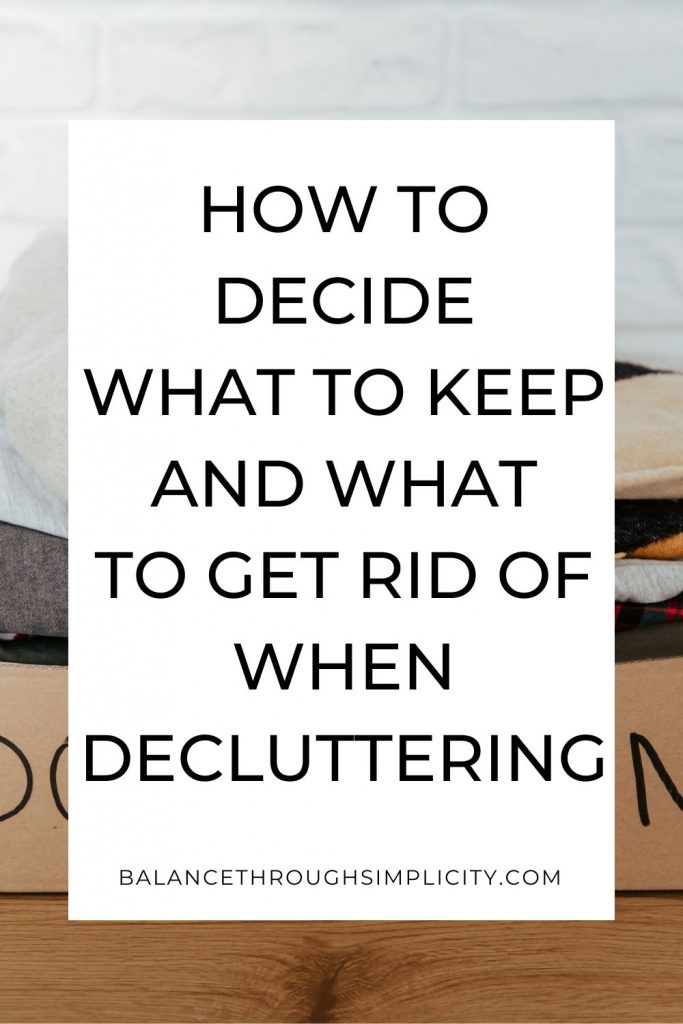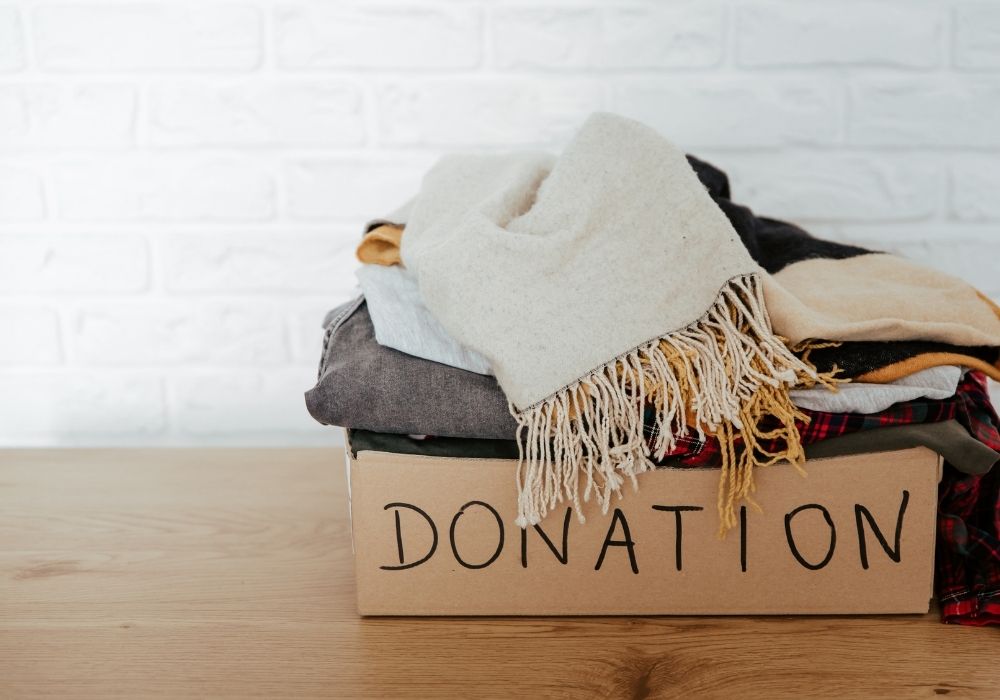DECLUTTERING DECISIONS: HOW TO DECIDE WHAT TO KEEP AND WHAT TO GET RID OF WHEN DECLUTTERING
Sometimes it’s difficult knowing what to declutter. How do you know whether to get rid of something or keep it? Let’s simplify the process, get clear on your why and give you some tips to help you know how to decide what to keep and what to get rid of when decluttering.
DECLUTTERING DECISIONS AND HOW TO DECIDE WHAT TO KEEP AND WHAT TO GET RID OF WHEN DECLUTTERING
As we’ll look at below, decluttering is easy for some and challenging for others. There are many reasons why some of us are clutter-free and others feel stuck with their clutter. If you struggle with decluttering, I hope this article will help you make better decluttering decisions and know how to decide what to keep and what to get rid of when decluttering some simple questions to ask and things to bear in mind to make those decluttering decisions easier.
WHY DO SOME PEOPLE FIND DECLUTTERING EASY?
Some people do find it really easy to sift through their possessions and work out what they want to keep and what they don’t.
Having a clutter-free home may come naturally to some of us. We might just prefer a more minimal (without necessarily being minimalist) aesthetic in our homes. You might like the look of having less stuff and clear lines of sight when you look around your home or you may just be naturally organised, methodical, neat and the thought of clutter building up and stuff everywhere makes you dizzy.
Perhaps you don’t have many material possessions, prefer experiences over physical items or live by yourself so you don’t have added clutter from other members of your household. I know myself that I’d naturally live a more clutter-free life without my kids and hoarder-husband living with me!
You may even have moved home several times, so you’ve gone through the contents of your home regularly and maybe decluttered as part of your house move.
Some homes and their occupants just enjoy and create a more clutter-free living space. For them, it feels easy to know what to declutter.

WHY DO SOME PEOPLE FIND DECLUTTERING REALLY HARD?
On the other hand, becoming and staying clutter-free is a challenge for many.
Some people find the thought and process of getting rid of much-loved possessions too traumatic to even contemplate.
They may place huge sentimental value on material things including gifts, keepsakes and souvenirs. If you struggle in this area, check out my post on how to declutter sentimental items.
It may be that you haven’t moved home for many years so never really thought about how much stuff you actually own. It can be quite a shock to go through the home and box everything up and discover how much we accumulate over time!
Or sometimes, the clutter just builds up without us noticing until the day comes when we think we should have a sort-out. And then it’s only to find there’s so much clutter that you don’t know where to start and so you don’t get started at all.
For some people, too much clutter is a sign of a more deep-seated emotional vulnerability. Maybe you ‘hide’ behind your clutter or you feel ‘safe’ with a comfort blanket of familiar stuff around you.
Maybe you’re consciously or otherwise, living in the past with keep-sakes and sentimental items all around, rather than making your home suit you (and perhaps your family) right here, right now.
WHY DO YOU WANT TO DECLUTTER?
In a moment, we’ll be looking at some simple questions you can ask yourself when it comes to choosing what to keep and what to get rid of when decluttering.
Before that though, and perhaps before you even begin to declutter, I’d like to give you some things to think about. They’ll help you get into the right mindset and make the actual process of decluttering easier. It’s about laying the groundwork first!
The first thing to know is what decluttering means to you.
- Is it a quick way of getting rid of the stuff in your home?
- Is it about making your home easier to manage and keep clean?
- Is it a way of bringing change into your home and life?
- Are you preparing for a move?
- Do you want to simplify your life and give yourself more time and freedom?
- Are you even decluttering to raise some money to pay off debt or buy something?
We declutter our homes for different reasons but it’s important to get clear on why you want to declutter right now. This will help you know how to decide what to declutter.
Action point: Grab a notebook and write down the reasons why you want to declutter. Keep these in mind in case you struggle and need a reminder!
WHAT WILL DECLUTTERING GIVE YOU?
Decluttering isn’t just getting rid of stuff for the sake of it. Even if you think of it in terms of getting rid of too much stuff so you have more space, there’s still a reason for it. In this case it would be GET RID OF STUFF = MORE SPACE.
Decluttering should give you something in return – there has to be a benefit. So, get clear on the exact benefits and you’ll have more motivation to declutter.
Action point: Go back to your notebook and look at what you wrote in the exercise above. Next to your answers write down exactly what decluttering will give you. Be as specific as you can.
- If you wanted more space, describe exactly what more space will give you – more walking room, more room for your kids to play, less cramped home because you need less storage if you have less stuff?
- If you wanted an easier home to manage, describe how this will help you – less time cleaning, more time for yourself?
- If you wanted to be more organised, describe how decluttering will help you – you hope to find things quicker and lose them less, make it easier to file things, have a clearer desk so you can be more efficient and productive?

UNDERSTAND TRADE-OFFS
When I decluttered my own home I donated many of my books. I had many that I’d read and wouldn’t read again or had been meaning to read but hadn’t got around to. I had quite a few shelves with books and I had to buy additional shelves for the books to live on.
In decluttering my books I decided what to keep and what to get rid of. I knew I didn’t want to keep all of them but I also knew that there may come a day when I’d want to read something I’d no longer kept. There was a trade-off. If I wanted to read a book I hadn’t kept, then I’d go to the library or borrow it from a friend. Yet the space I’d created by clearing my books and the storage I’d needed to home them had greater benefit so I decluttered anyway.
There might come a time when you need an item you’ve decluttered but think about what you’re gaining when decluttering instead of what you’re getting rid of. Understand the trade-off and decide which is most important to you?
DEFINE YOUR PRIORITIES
In simplifying life, the key component is to get clear on what you want and why. That’s the thread that’s been weaving through the points above and it’s important to help you know what to keep and what to get rid of when decluttering.
Knowing why you’re decluttering, what it will give you and understanding trade-offs (the three points we’ve looked at above) is about defining your priorities.
- Do you want a home that’s full of sentimental items from the past or a home that suits your family in the present?
- Do you want a busy, cluttered space that’s difficult to clean and sucks your time or do you want more time for yourself and to spend with family and loved ones?
Action point: Sit for a moment and reflect on what’s most important to you in life right now. Does your home and what’s in it support you or does it get in the way of what’s most important?
SO HOW TO DECIDE WHAT TO KEEP AND WHAT TO GET RID OF WHEN DECLUTTERING?
Now that you’ve got clear on what you want to achieve by decluttering (more space, more time, less stress etc), you’re probably more able to decide what’s clutter.
Keep your priorities in mind and every time you declutter an item or area in your home ask yourself some simple questions.
1. Do I need this item?
Is the item useful? Does it have a purpose and do you use it often enough to justify keeping it? If it’s a high value item that you use, but not very often, and would be expensive to replace, then keep it. If the item’s not useful, doesn’t serve a purpose or you can easily buy, borrow or rent a replacement, then let it go.
Think carefully about how many items you keep back ‘just in case’ and work out whether you have enough of those ‘just in case’ moments to justify having to look after the item for the rest of the time.
2. Do I love this item?
Maybe it’s something you love to look at, or it reminds you of something that you love to do, a place you love to be or someone you used to love. Or it could be something that you love to use or to wear. If you LOVE it, then keep it. Liking something isn’t good enough. You have to LOVE it.
3. Do I want it?
This question is about whether the item adds value to your life or you appreciate it enough to make space for it in your home or your life. It might not be something that you love, or you need, but it’s something that you really, really WANT in your life.
Ask yourself whether your life is enhanced by having this item in your life and would your life be any less if this item wasn’t in it? If you really WANT it, then keep it. Just be mindful that you can’t want everything!
If you find yourself with this dilemma then sort out your WANT pile and prioritise it. Keep the three most important things and let the rest go. You don’t WANT them badly enough or you’d have put them at the top of the list!
4. How often do you use it?
We’ve looked already at whether you need the item, but ask yourself how often do you use it? You might need it but do you actually only use it once every year or two. If this is the case, do you really need to look after and store it the rest of the time? If you use the item regularly, every day or week, then it’s probably worth keeping.
5. Does it have an expiry date?
This doesn’t just apply to food but also things like medicines and make-up. Check the dates, throw out anything that’s past its best and only replenish what you’re going to need and use.
6. Can you borrow, loan or rent it?
When my kids were younger, we did a lot of camping. However, I didn’t want the camping equipment taking up space in our small home so we borrowed the gear when we needed it. Can you do the same for items that you don’t use often so that they’re not lying around cluttering up your home for the rest of the year?
7. Would you buy it now?
Always a good litmus test for whether it’s important and will add value to your life in some way. If you didn’t have the item already, would you buy it again or would you be unsure? If you’re unsure then it’s likely that you don’t use, need or love it as much as you could!
8. Was it a gift?
Some of the things we have in our homes aren’t bought by us or of our choosing. Just because someone bought you something doesn’t mean you have to keep it. Accept it graciously, say thank you, take a photo and then donate it to someone else who could benefit from it more.
9. Does it make you feel guilty to part with it?
This doesn’t just apply to gifts. For example, you might have spent a month’s salary on a new handbag so, even though you don’t use it very much (or even like it much now), you feel guilty for getting rid of it because it cost so much to buy in the first place. Or, you might have decided to take up sewing, bought all the equipment and materials and then found it too difficult or time-consuming. There’s no guilt in back-tracking on a decision, you’re not a failure for giving something up that doesn’t work for you, and there’s no guilt in getting rid of something because it’s no longer serving or supporting you.
10. Is there a purpose in keeping it?
By this I mean warranties on products just in case they’re faulty, or tax documents that you have to keep for a certain number of years, or passports and other legal documents such as wills. Much of our paperwork can be scanned and saved electronically but sometimes we need to keep the original, physical copies.
11. Can it be repurposed?
An example of this could be sentimental items such as old photos, or your child’s drawings or baby clothes. What about taking a photo of these and keeping that rather than the actual item?
12. Do you have duplicates?
How many clothes hangers do you need? Or mugs, plates, cutlery? Having more of an item than you really need just adds to the clutter so get rid of duplicates whenever possible.

DECLUTTERING GETS EASIER WITH PRACTICE
Over time, many people find that decluttering gets easier with practice. Not only will you have less stuff to sort through after a few successful decluttering sweeps but you’ll begin to intuitively know what to keep and what to get rid of. You may find that you need to re-visit some of the questions above, or review your priorities every now and then, but it will be a more natural process to remove the stuff that you no longer appreciate or need.
A WORD OF CAUTION
Decluttering isn’t something you do because everybody’s doing it and you feel you should do it too. Decluttering won’t make life easy and it won’t change your life if you do it in haste and throw the metaphorical baby out with the bath water.
Decluttering is a wonderful tool to bring more calm and ease to your life, but you won’t win a medal for getting it all done by yesterday.
Be kind to yourself, go gently.
Years of clutter won’t disappear in a weekend. Go at a pace that feels right to you. Be clear on why you’re doing it and what you want to achieve. This is far more important than chucking things out just for the sake of it!
The questions we’ve looked at above and reflecting on your own reasons for decluttering will support you to know how to decide what to keep and what to get rid of when decluttering and keep that clutter away.
RESOURCES FOR DECLUTTERING
If you’d like to explore what decluttering your home and life could mean for you, here are some resources which you might find helpful:
- How to declutter your home and life – a complete guide to clearing your clutter and keeping it away!
- 20 ways to declutter your home – tips and projects to try today.
- 20 daily habits for a clutter-free home – stay on top of the clutter by doing a little bit every day to keep the clutter at bay
- 10 reasons to declutter your home
A FREE DOWNLOAD
My Declutter Starter Kit is a free guide and workbook to help you understand the what, why and how of decluttering. It will help you explore some of the questions we’ve talked about in this article and help you get clear on what you want to achieve and why.
Pop your details in the box below for your free copy packed with projects, tips and guidance to clear the clutter in your home and life.
DON’T MISS OUT!
I’m Antonia and on this blog I share practical inspiration to simplify your home, time and life. Follow me on Instagram, Facebook and Pinterest! You can also subscribe to Balance Through Simplicity and receive regular simplicity tips straight to your inbox for free. Make sure you never miss an article plus you’ll get a copy of my free Declutter Starter Kit as a welcome gift!

